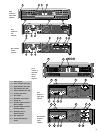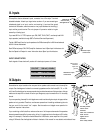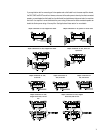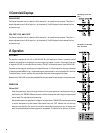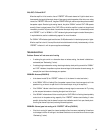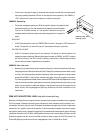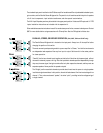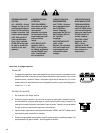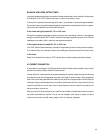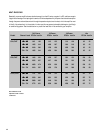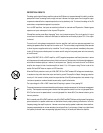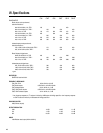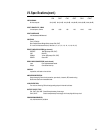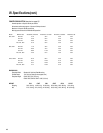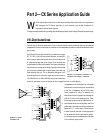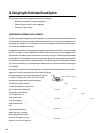13
MAXIMUM LONG-TERM OUTPUT POWER
In a properly designed sound system, you can obtain the desired sound level without using the full output power
of the amplifier; if the “CLIP” indicators flash once in a while, that is perfectly normal.
If the amplifier is operated at extremely high power levels, it may overheat or may even damage the speakers.
The amount of stress on the amplifier depends largely on the load and how hard the amplifier drives it. In general,
the lower the load impedance, the more stressful the load is.
8-Ohm Loads and Lightly Loaded 25V, 70V, or 100V Lines
The amplifier can operate at practically any power level without risk of overheating. However, if it is pushed hard
enough to continually light the “CLIP” indicator, the amplifier’s average output power can reach 110 to 475 watts
(depending on the model), which is more than many speakers can handle.
4-Ohm Loads and Heavily Loaded 25V, 70V, or 100V Lines
If the “CLIP” indicator flashes occasionally, the amplifier is approaching its maximum long-term power capacity.
If it is lit about half the time, the amplifier channel will probably go into thermal protection within a few minutes.
2-Ohm Loads
Except for an occasional flash, keep the “CLIP” indicator dark to avoid overheating the amplifier channel.
AC CURRENT CONSUMPTION
A major objective in the design of the CX Series amplifiers-even the higher-powered models-is to permit their
operation from readily available, standard AC power sources.
“Normal conditions” in power amplifier rating means operating with a random program source (pink noise), using
pink noise as a source, at an average power level equal to one-eighth of maximum power. This is recognized by
most of the world’s safety agencies as the loudest you can play music through an amplifier and still keep the
incidence of clipping to a reasonable minimum. An amplifier’s peak current draw at full output power into 2 ohms
is several times what the “normal” draw is, but its various protection circuits will prevent this condition from
lasting more than a minute or two.
When you plan the AC power hookups for your amplifiers, use the table in the Specifications section to predict
the current requirements per amplifier. You can use the one-eighth power figures to predict the normal
continuous current draw, then add a safety margin to allow for occasional crescendos.



